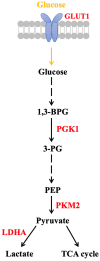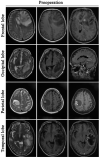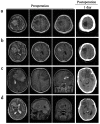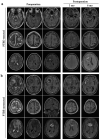Peri-tumoral brain edema associated with glioblastoma correlates with tumor recurrence
- PMID: 33754006
- PMCID: PMC7974512
- DOI: 10.7150/jca.53198
Peri-tumoral brain edema associated with glioblastoma correlates with tumor recurrence
Abstract
Glioblastoma is the most common malignant tumor of the brain. Despite advances in treatment, the prognosis for the condition has remained poor. Glioblastoma is often associated with peritumoral brain edema (PTBE), which can result in increased intracranial pressure and devastating neurological sequelae if left untreated. Surgery is the main treatment for glioblastoma, however current international surgical guidelines do not specify whether glioblastoma-induced PTBE tissue should be resected. In this study, we analyzed treatment outcomes of PTBE using surgical resection. We performed a retrospective analysis of 255 cases of glioblastoma between 2014 and 2016, and found that a significant proportion of patients had a degree of PTBE. We found that surgical resection led to reduction in midline shift that had resulted from edema, however, postoperative complications and KPS scores were not significantly different in the two conditions. We also observed a delay in glioblastoma recurrence in patients undergoing PTBE tissue resection vs patients without resection of PTBE tissue. Interestingly, there was an abnormal expression of tumor associated genes in PTBE, which has not been previously been found. Taken together, this study indicates that glioblastoma-induced PTBE should be investigated further particularly as the tumor microenvironment is a known therapeutic target and therefore interactions between the microenvironment and PTBE should be explored. This study also highlights the importance of resection of PTBE tissue to not only reduce the mechanical obstruction associated with edema but also to delay recurrence of glioblastoma.
Keywords: Glioblastoma; Peritumoral brain edema; Recurrence; Tumor resection..
© The author(s).
Conflict of interest statement
Competing Interests: The authors have declared that no competing interest exists.
Figures





Similar articles
-
Impact of peritumoral brain edema on pre- and postoperative clinical conditions and on long-term outcomes in patients with intracranial meningiomas.Eur J Med Res. 2023 Jan 21;28(1):40. doi: 10.1186/s40001-022-00962-y. Eur J Med Res. 2023. PMID: 36670509 Free PMC article.
-
EXTENSIVE PERITUMORAL BRAIN EDEMA IN A SMALL CLINOIDAL MENINGIOMA: CLINICAL CASE.Wiad Lek. 2021;74(10 cz 2):2678-2681. Wiad Lek. 2021. PMID: 34923480
-
High delta-like ligand 4 (DLL4) is correlated with peritumoral brain edema and predicts poor prognosis in primary glioblastoma.Medicine (Baltimore). 2014 Aug;93(8):e57. doi: 10.1097/MD.0000000000000057. Medicine (Baltimore). 2014. PMID: 25121357 Free PMC article.
-
Intracranial meningiomas, the VEGF-A pathway, and peritumoral brain oedema.Dan Med J. 2013 Apr;60(4):B4626. Dan Med J. 2013. PMID: 23651727 Review.
-
Peritumoral edema in meningiomas: pathophysiology, predictors, and principles for treatment.Clin Transl Oncol. 2023 Apr;25(4):866-872. doi: 10.1007/s12094-022-03009-0. Epub 2022 Nov 24. Clin Transl Oncol. 2023. PMID: 36427121 Review.
Cited by
-
Different Effects of Phototherapy for Rat Glioma during Sleep and Wakefulness.Biomedicines. 2024 Jan 24;12(2):262. doi: 10.3390/biomedicines12020262. Biomedicines. 2024. PMID: 38397864 Free PMC article.
-
Retrospective longitudinal assessment of optic nerve sheath diameter in patients with malignant glioma.Cancer Med. 2023 Dec;12(24):22047-22055. doi: 10.1002/cam4.6789. Epub 2023 Dec 8. Cancer Med. 2023. PMID: 38063340 Free PMC article.
-
Distinguishing glioblastoma progression from treatment-related changes using DTI directionality growth analysis.Neuroradiology. 2024 Dec;66(12):2143-2151. doi: 10.1007/s00234-024-03450-8. Epub 2024 Aug 17. Neuroradiology. 2024. PMID: 39153088 Free PMC article.
-
Dexamethasone and overall survival and progression free survival in patients with newly diagnosed glioblastoma: a meta-analysis.J Neurooncol. 2024 Jan;166(1):17-26. doi: 10.1007/s11060-023-04549-3. Epub 2023 Dec 27. J Neurooncol. 2024. PMID: 38151699
-
Ferroptosis and PPAR-gamma in the limelight of brain tumors and edema.Front Oncol. 2023 Jul 24;13:1176038. doi: 10.3389/fonc.2023.1176038. eCollection 2023. Front Oncol. 2023. PMID: 37554158 Free PMC article. Review.
References
-
- Pisapia DJ. The Updated World Health Organization Glioma Classification: Cellular and Molecular Origins of Adult Infiltrating Gliomas. Arch Pathol Lab Med. 2017 Dec;141(12):1633–45. - PubMed
-
- Woernle CM, Péus D, Hofer S, Rushing EJ, Held U, Bozinov O. et al. Efficacy of Surgery and Further Treatment of Progressive Glioblastoma. World Neurosurg. 2015 Aug;84(2):301–7. - PubMed
-
- Ideguchi M, Kajiwara K, Goto H, Sugimoto K, Nomura S, Ikeda E. et al. MRI findings and pathological features in early-stage glioblastoma. J Neurooncol. 2015 Jun;123(2):289–97. - PubMed
LinkOut - more resources
Full Text Sources
Other Literature Sources

